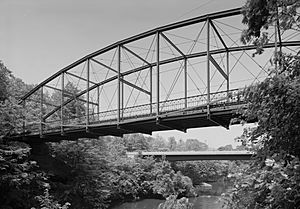Lover's Leap Bridge facts for kids
Quick facts for kids Lover's Leap Bridge |
|
|---|---|

Lover's Leap Lenticular Bridge
|
|
| Coordinates | 41°32′39″N 73°24′25″W / 41.54417°N 73.40694°W |
| Carries | Pedestrians |
| Crosses | Housatonic River |
| Locale | Lovers Leap State Park, New Milford, Connecticut |
| Maintained by | Connecticut Department of Environmental Protection |
| Characteristics | |
| Design | Lenticular through truss |
| Total length | 173 feet (53 m) |
| History | |
| Opened | 1895 |
| Statistics | |
| Toll | None |
|
Lover's Leap Bridge
|
|
| Lua error in Module:Location_map at line 420: attempt to index field 'wikibase' (a nil value). | |
| Location | New Milford, Connecticut |
| Area | 1 acre (0.4 ha) |
| Built | 1895 |
| Architect | Berlin Iron Bridge Co.; Douglas & Jarvis |
| NRHP reference No. | 76001982 |
| Added to NRHP | May 13, 1976 |
The Lover's Leap Bridge is a special bridge in Lovers Leap State Park in New Milford, Connecticut. It crosses the Housatonic River. This bridge was built in 1895 by the Berlin Iron Bridge Company. It is made of wrought iron and has a unique shape called a lenticular truss. The bridge is very old and beautiful. It is now only used by people walking, not cars. In 1976, it was added to the National Register of Historic Places.
What makes this bridge special?
The Lover's Leap Bridge is found south of downtown New Milford. It is in the northern part of Lovers Leap State Park. The bridge crosses the Housatonic River not far from where the Still River joins it. You can reach the bridge by walking from parking areas nearby. It used to be part of Pumpkin Hill Road.
How the bridge is built
This bridge has a single span, meaning it crosses the river in one continuous section. It is made of wrought iron and is about 173 feet long. The bridge rests on strong stone supports called abutments. Its parts are joined together with pins.
The ends of the bridge have special posts topped with decorative urns. The crisscross patterns at the entrances are arched and have fancy crests. Even the guard rails have pretty rosette decorations. This makes the bridge a very ornate and beautiful example of its kind.
Its history and use
The Berlin Iron Bridge Company built the Lover's Leap Bridge in 1895. This was one of the last bridges the company made from iron. Around that time, steel was becoming more popular for building bridges.
The bridge was used by both cars and people walking until 1977. After a new crossing was built just north of it, the Lover's Leap Bridge was closed to cars. Now, it is a peaceful spot for pedestrians to enjoy the park and the river views.

